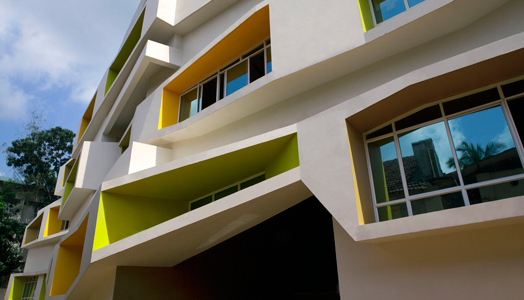By Marina Correa
Photography: Lalita Tharani + Ajeeb; courtesy
Collaborative Architecture
 |
| . |
The JDT Primary School for
orphans, designed by Collaborative Architecture is a befitting example of socially
responsible catalyst architecture that proves that ‘good design need not be
expensive’.
This Lego-shaped project is
part of a prosaic JDT Islam campus, the very first Muslim orphanage in India,
located in a small village in Calicut, Kerala, whose built environment was characterized
by highly disparate styles and mediocre buildings.
.jpg) |
| Concept Sketch |
The site that was
identified to be a primary school was a linear left over track between a girl’s
school and an existing old school building; added to this, unplanned massing,
restricted sources of wind and light; and a limited budget in a village with
limited skills and resources were some of the design challenges that lay before
the firm.
.jpg) |
| . |
Known for their astute
designs, principal architects Lalita Tharani and Mujib Ahmed decided that their
architectural intervention would not only approach the project as a catalyst,
paving the way forward, but also work as a responsive, immersive and
progressive tool for the community.
.gif) |
| . |
Designed as a porous and inviting
convergence of classrooms and spaces for interaction rather than as typical
regimented rectilinear blocks – the structure transforms the quality of
architecture on campus; evoking sensorial attributes that maintain an
‘intrigue’ factor for the children. Like Lego, it changes form in dramatic ways
as one views it from different angles.
Internally, the classrooms
are oriented around ancillary spaces to encourage interaction among students
and teachers; corridors become meeting points and double up as open classrooms.
.jpg) |
| . |
Furthermore, vibrantly
coloured, asymmetrically-shaped large windows extend the intrigue factor within
the building and add an unconventional touch normally not associated with
school buildings. They also succeed in ushering in natural light and an airy
environment.
.jpg) |
| . |
Besides dramatically enhancing
the overall look of the campus, the primary school building belies the fact
that it was built on just a narrow strip of wedged land; its dynamic
architectural vocabulary speaking volumes for its relevance in the lives of the
orphans, who are educated here.
The project is the proud
recipient of the Social Economic Environmental Design Awards (SEED Awards) for
2012 and more recently, the NDTV Design & Architecture Award for 'Socially
Relevant Architecture of the Year 2014’.

.jpg)
nice architecture!
ReplyDeletea very interesting article to read, in such a detailed and expressive manner! kudos!
ReplyDelete